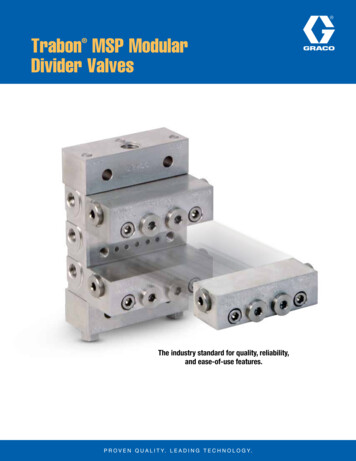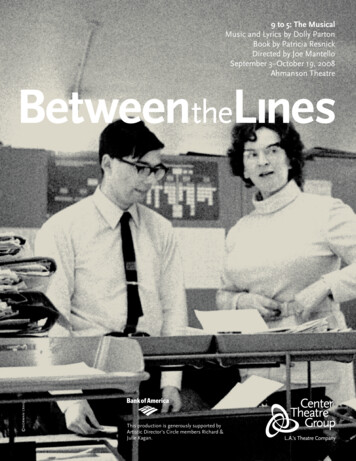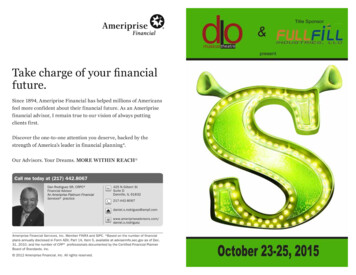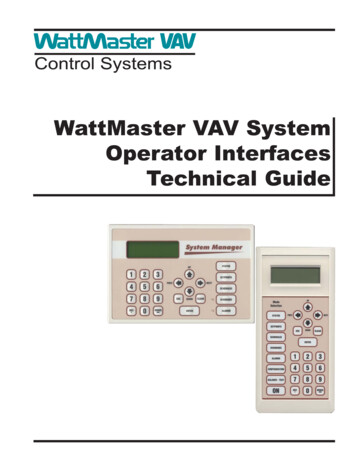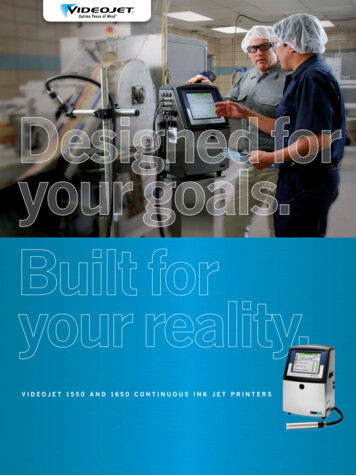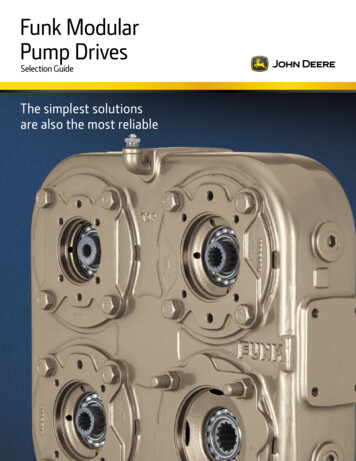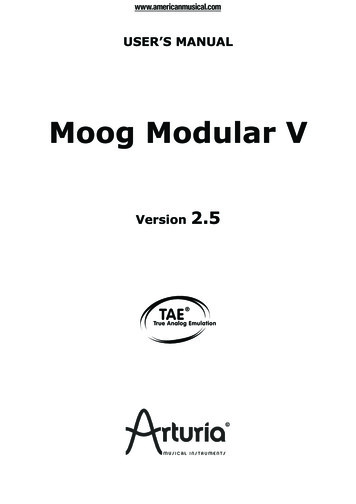
Transcription
USER’S MANUALMoog Modular VVersion2.5
Programming:Robert BocquierNicolas BronnecPierre-Jean CamilieriSylvain GubianXavier OudinGilles PommereuilCedric RossiGraphics:Yannick BonnefoyThomas & Wolfgang Merkle [Bitplant]Manual:Antoine Back (V2.5)Silvère Letellier (V2.5)Jean-Michel BlanchetTomoya FukuchiTom HealySadahiro NakanoXavier OudinGilles PommereuilCedric RossiTakashi UesugiYuji SanoSound Designers:Wally BadarouJean-Michel BlanchetCelmar EngelMichel GeissChristoff HarbonierMateo LupoHideki MatsutakeScot SolidaKatsunori UjiieVery special thanks to:Robert A. Moog and Isao TomitaThanks to:Michael Adams, Bruno Begani, Ned Bouhalassa, Geoff Downes, Clay Duncan, PavleKovacevic, Roger Luther, Sadahiro Nakano, Fabrice Paumier, Ben Turl, Peter Willems,and the numerous beta testers. ARTURIA SA – 1999-2009 – All rights reserved.4, Chemin de Malacher38240 MeylanFRANCEhttp://www.arturia.comInformation contained in this manual is subject to change without notice and does not represent a commitment on thepart of Arturia. The software described in this manual is provided under the terms of a license agreement or nondisclosure agreement. The software license agreement specifies the terms and conditions for its lawful use. No part ofthis manual may be produced or transmitted in any form or by any purpose other than purchaser’s personal use,without the express written permission of ARTURIA S.A.Other products, logos or company names quoted in this manual are trademarks or registered trademarks of theirrespective owners.
Introduction to version 2.5 of the Moog Modular V manualThe first version of the Moog Modular V wascommercialized in March 2003 having beenannounced at the NAMM show of the sameyear.It quickly became popular being the first toofferanemulationofamodularsynthesizer.The name Moog was obviously a triggeras for many it remains synonymous withthe golden age of vintage synthesizers. Butstrong interest from well-known musicianssuch as Isao Tomita, Klaus Schultze, GeofDownes, Stevie Wonder, Herbie Hancockand many others helped create a real buzzaround the launch of the Moog Modular V.At Arturia, we have received manymessages of congratulations as well asrequests for the evolution and modificationsfor upcoming versions of the synthesizer.Version 2 of the Moog Modular V has takenmany of these requests into account andbrings many unexpected developments.Firstly, as you will see when you launch theprogram, is a new means of viewing thesynthesizer giving an overview of the entireinstrument if your computer can supportthe resolution. On screens with lowerresolutions, by using the “scroll” command,it becomes possible to access all of themodules on the same screen, a feature thatwill delight many musicians.We have also broadened the configurationpossibilities for the synthesizer. Somemodules can now be interchanged, whichbrings the Moog Modular V closer to theoriginalinstrumentsthatcouldbeconfigured by Moog Music upon order.Improvements have also been made to theaudio, making use of the evolution of ourTAE technologywhichhasseenimprovements during the year. We haveanswered a frequent request in relation toAudio-in so that you can now use the MoogModular V filters or sequencer on anexternal source.Of course, we have also developed newmodules, six to be precise. The 928(Sample and Hold) and 912 (EnvelopeFollower) were popular demands and canbe found in this new build.Also added are very rare modules such asthe 1630 Bode Frequency Shifter – arounda dozen models produced - or completelynew modules such as the Formants FilterLast but not least is the addition of 200 newpresets to this version. They make use ofthe new options offered by the MoogModular V, and will be a great starting pointfor those who wish to discover this newversion. Go to the last part of Chapter 7 ifyou wish to jump into using the newmodules offered.Hoping that you enjoy this evolution, wewish you the greatest pleasure in your useof the Moog Modular V 2.5The Arturia team
TABLE OF CONTENTS1Introduction71.1The birth of modular moog systems1.2A modular synthesizer, why?1.3A better emulation thanks to TAE 1.3.1Aliasing-free oscillators:1.3.2Better reproduction of analog wave forms:1.3.3Better reproduction of analog filters1.3.4Implementation of soft clipping2Installation2.12.23Windows Installation (XP, VISTA, 7)Installation MacOS XAUTHORIZATION4Quick Start7101111121314161618Error! Bookmark not defined.224.1The 4 sections of the Moog Modular V4.1.1The synthesis section4.1.2The other three sections4.1.3Reduced view of the keyboard and the real time controllers4.2Using presets4.3Modular synthesizer4.3.1First connections4.3.2Description of the synthesis section modules4.4The other sections4.4.1The sequencer4.4.2The effects4.5the virtual keyboard and its real time controllers4.5.1The keyboard4.5.2The keyboard controllers4.5.3The play modes4.5.4The sound design controllers5The g the presets5.1.1Choice of bank, sub-bank, preset5.1.2Creation of a bank, sub-bank, preset5.1.3Saving a user preset5.1.4Import / Export of a preset bank5.2Work pages5.2.1The complete view:5.2.2The reduced usage page5.3Using .3.4Keyboard5.3.5MIDI Control5.4Using cables5.4.1Audio and modulation connections5.4.2Modifying a connection5.4.3Modulation level setting5.4.4Cable display options5.4.5Trigger connections5.4.6Synchronization connections5.4.7Key follow or sequencer connections6The 8606.1Programming section6.1.1Description6060
6.1.2Oscillators6.1.3Filters6.1.4Modulation envelopes6.1.5Output amplifiers (VCA)6.1.6Low frequency oscillators (LFO)6.1.7Controlled amplifiers / Mixers6.1.8Trigger delay6.1.9Noise generator6.1.10Sample and hold6.1.11Envelope follower6.1.12Ring modulator6.1.13Formant Filter6.1.14Bode Frequency Shifter6.2Second section6.2.1Description6.2.2Resonant filter bank6.2.3Chorus6.2.4Phaser6.2.5Stereo Delay6.2.6Sequence generator6.3Third Section6.4Fourth section6.4.1Keyboard follow management6.4.2General settings7The basics of subtractive 1929293957.1The three main modules7.1.1The oscillator or VCO7.1.2The filter or VCF7.1.3The amplifier or VCA7.2Complimentary modules7.2.1The keyboard7.2.2The envelope generator7.2.3The low frequency oscillator8A few elements of sound design9595981021021021021031058.1Modular sound synthesis8.1.1Simple patch n 18.1.2Simple patch n 28.1.3Complex patch n 18.1.4Complex patch n 28.2The sequencer8.2.1Sequence n 18.2.2Sequence n 28.2.3Sequence n 38.3Bonus features8.3.1Creative use of key follows8.3.2Creative use of triggers and trigger delays8.3.3Stereo without the effects8.4using the new Moog Modular V 2.0 modules8.4.1The Bode Frequency Shifter8.4.2The Envelope Follower8.4.3The sample and hold9Using the Moog Modular V in different 1291321369.1Stand-alone9.1.1Launching the application9.1.2Setting preferences9.1.3The control bar9.1.4Information on the level of processor use9.1.5Panic136136136137138138
.4.29.5Saving an instrumentUsing your plug-in in a hostMidi connectionSaving presetAutomationVST Cubase Ableton Live Sonar Audio unitLogic Studio Digital Performer Pro Tools (RtaS)138138138139139139139141144145145146149
11.1INTRODUCTIONTHE BIRTH OF MODULAR MOOG SYSTEMSRobert A. Moog was born in May 1934 in New York. A passionate for music (he took pianolessons for 12 years), he was introduced to electronics by his father, an engineer in thisdomain. During his adolescence, he discovered the Thereminvox plan, invented during the 30’sby a Russian engineer, Leon Theremin (or more exactly Lev Sergeivitch Termen). Seduced bythis instrument with its never before heard sounds, he began to produce his own models andfounded his own company in 1954.Frequenting musical professionals, and in particular electronic and concrete music, R. Moogrealized that there was a real demand for electronic instruments of a higher quality.One of the first clients to come to Robert Moog, the professor of music Herbert A. Deutsch,asks him to listen to a song he had composed. Moog is immediately convinced and they decideto associate their work. Their co-operation produced the first VCO.In 1964, the first prototype of a Moog synthesizer was produced. It was a modular system witha voltage controlled filter (VCF), an envelope generator, a white noise generator, a trigger andtwo keyboards each with a generator module (sawtooth, triangle and impulsion) as well as avoltage controlled amplifier module (VCA).The first modular Moog system (1964) (Courtesy of Roger Luther, MoogArchives.com)Then other musicians helped Robert Moog in creating different modules:Walter Carlos (who later became Wendy) helped for elaboration of a sequencer. He alsopushed Bob Moog to lend his name to his machines.Vladimir Ussachevsky, who was one of the professors of de W. Carlos, specified the 4 parts ofthe envelope generator (ADSR), allowing the accomplishment of the VCA and gave him theidea for the envelope follower.Gustave Ciamaga helped with the creation of the first tension controlled low-pass filter.ARTURIA – MOOG MODULAR V 2.5 – USER’S MANUAL7
A second prototype, regrouping the all of the new modules, was built during the summer of1964 and was presented during the AES show (Audio Engineering Society), where Moogworked from an unused stand. This new product generated a huge amount of interest, butMoog did not yet realize the commercial punch of his machines. Two or three orders wereobtained at AES and kept Moog busy for several months. In 1965, after the success at theshow, Moog decided to release the 900 series for commercial sale.The R.A. Moog Company at Trumansburg, NY (Courtesy of Roger Luther, MoogArchives.com)The first client to buy the full Moog system was choreographer Alwin Nikolais. Also among thefirst users were composers Eric Siday and Chris Swansen. The first commercial uses of theMoog synthesizers were done in advertising. They were also used for jingles and in recordingstudios.In 1967, Bob decided to release different machines each with a certain number of modules.This marked the birth of modular systems I, II and III. This same year, Paul Beaver for thefirst time used a modular Moog system on a record.The modular system III (1967) (Courtesy of Roger Luther, MoogArchives.com)In 1968, worldwide recognition came with the success of “Switched-On Bach” by W. Carlos.This album, where classical music is played on a Moog, sold over one million copies as it was8ARTURIA – MOOG MODULAR V 2.5 – USER’S MANUAL
bought both by classical music fans (it was in the American “Classical” charts for 94 weeks)and fans of pop. It won three Grammy awards.“Switched-On Bach” by W. CarlosA little later, Keith Emerson, keyboard player for the groups Nice and ELP (Emerson, Lake andPalmer), was he himself to become an ambassador for Moog synths. He was one of the first toplay a Moog modular on stage during a tour (A 3C system). Jan Hammer was also one of thefirst users of Moog systems. Big groups like Tangerine Dream, the Beatles or the RollingStones, would also become modular Moog owners.The 3C modular system (1969) (Courtesy of Roger Luther, MoogArchives.com)In 1969-70, the company which now has around forty employees was building up to threemodulars per week and the order book was always full.The modular had 5 years of high sales, and sold around 200 models in the United States.ARTURIA – MOOG MODULAR V 2.5 – USER’S MANUAL9
Construction and testing of a modular Moog (Courtesy of Roger Luther, MoogArchives.com)In 1969, Bob Moog received demands for a more compact instrument that could betransported more easily, directed more to stage than studio. With the help of an engineer fromBerkley, Jim Scott, and the advice from numerous musicians he was about to create anothermythic synth: the Minimoog System 55, the last version of the Moog modular (1974)(Courtesy of Roger Luther, MoogArchives.com)1.2A MODULAR SYNTHESIZER, WHY?Why create a modular synthesizer, that is to say comprised of independent modules that wemust connect ourselves, sometimes with difficulty, before obtaining a sound?The answer, as you can imagine, is very simple: the modularity brings immense possibilitiesfor the creation of sound.To convince you, lets look at some basic concepts.10ARTURIA – MOOG MODULAR V 2.5 – USER’S MANUAL
Sound synthesis is essentially based on the use of generators and filters. From thesecomponents, the sound designer must create sounds that can be used by musicians. Tosucceed, the different parameters that we have access to (height of note, filter cut-offfrequency, output volume, wave form ) must evolve in time. And for this, we must linkdifferent modules between each other.Let’s take an example: an oscillator, which has inputs to modulate each of its parameters.Let’s connect the output of an envelope generator to the oscillator frequency modulation input,and there we get a signal depending on the use of a keyboard. Now we’ll connect a lowfrequency generator to the impulse width modulation input and here we have the waveform,which will evolve in time.But why not have internal cables, fixed from the start?Here again, another example will help. Let’s take an envelope and two oscillators. The latterpossess three modulation inputs: a frequency modulation, an impulse width modulation and avolume modulation.Effecting every combination with fixed connections would oblige us to have six independentbuttons for the modulation of the parameters.If we now take 9 oscillators, 6 envelopes, a modulation wheel and a velocity setting, we wouldneed 216 setting buttons.What can we therefore say for the Moog Modular V, which on top of this has three filters, anoise generator, a sequencer and two control pads.Connections in a modular synthesizer can sometimes seem difficult, but the often-unexpectedresults, are always a source of great musical inspiration.Either way, don’t worry, the presets created by experienced musicians will allow you, ifnecessary, a gentle introduction to the art of sound creation.This new version presents new modules and a notable improvement to the sound quality andsynthesis possibilities. As was the case with the previous versions, it remains faithful to theoriginal Moog Modulars and offers the possibility to organize the arrangement of certainmodules. Ergonomically this version remains very close to the previous so as not to loose timelearning the different functions again.1.3A BETTER EMULATION THANKS TO TAE TAE - standing for True Analog Emulation - is a new technology dedicated to the digitalreproduction of analog circuits.When implemented in software code, TAE’s algorithms guaranty the respect of hardwarespecifications. This is why your Moog Modular V offers an unparalleled quality of sound.In detail, TAE means:1.3.1Aliasing-free oscillators:Standard digital synthesizers produce aliasing in high frequencies, and when using Pulse WidthModulation or FM.TAE allows the production of totally aliasing-free oscillators in all contexts (PWM, FM ), andat no extra CPU cost.ARTURIA – MOOG MODULAR V 2.5 – USER’S MANUAL11
AliasingLinear frequency spectrum of an existing well-known software synthesizerLinear frequency spectrum of the Moog Modular V oscillator made with TAE 1.3.2Better reproduction of analog wave forms:Original analog oscillators used condensers’ unloading to produce common wave shapes (sawtooth, triangle, square). This means that waveforms were slightly curved. TAE allows thereproduction of Condenser’s Unload.Temporal representation of a waveform on a Modular Moog 5512ARTURIA – MOOG MODULAR V 2.5 – USER’S MANUAL
Temporal representation of the waveform of an existing Moog-like software synthesizerTemporal representation of the Moog Modular V waveform thanks to TAEIn addition, original analog oscillators were unstable. Actually, their wave shape was alwaysslightly different from one period to another. In addition, due to analog hardware sensitivities,new period trigger times varied with the temperature and other environmental conditions.TAE simulates the instability of oscillators, helping to create warmer and fatter sounds.1.3.3Better reproduction of analog filtersTAE allows the emulation of analog-designed filters in a much more precise way than anyexisting digital filter. In particular, TAE has managed to reproduce the legendary Moog 24dBlow-pass resonant filter with great respect towards the original.ARTURIA – MOOG MODULAR V 2.5 – USER’S MANUAL13
Standard 24 dB digital lowpass resonance filter for atypical softwaresynthesizerVery selective 24 dBresonance filter of theMiniMoogTAE made Moog ModularV resonance filter: First 24dB resonance filter to bethat selectiveComparative response filters1.3.4Implementation of soft clippingIn analog synthesizers, the resonant filter uses a current limiting function, preventing thesignal from being too loud (soft clipping).TAE reproduces this current limiting function, making the sound more natural. It also allowsfilters to enter self-oscillation like original hardware synthesizers do.Current limitingemulationInput14Low-pass resonant filterOutputARTURIA – MOOG MODULAR V 2.5 – USER’S MANUAL
Soft-clipping transfer functionARTURIA – MOOG MODULAR V 2.5 – USER’S MANUAL15
22.1INSTALLATIONWINDOWS INSTALLATION (XP, VISTA, 7)Insert the CD-ROM in the drive. Explore the CD-ROM content; double-click on the “MoogModular V 2 Setup PC.exe” iconAt the first step in the installation, choose the folder to install the Moog Modular V. It will beinstalled by default in C:\Program Files\Arturia\Moog Modular V 2. You can change thedestination with the Browse button.Choice of installation folderThe Moog Modular V2.5 will be installed as a standalone application. The following step allowsyou to install the Moog Modular V2.5 as a plug-in. To do this, choose the protocol(s) that youuse (VST, RTAS). For more information on these protocols, look at chapter 8.16ARTURIA – MOOG MODULAR V 2.5 – USER’S MANUAL
Choosing the protocolsFor the VST and RTAS protocols, you need to choose the installation folder to allow the hostapplication to use the Moog Modular V2.5 as a plug-in. If you do not know how to make thischoice, go to chapter 9.Installation folder choice for the VST plug-inThe installation program now has enough information to complete the installation. When theinstallation process is completed, please proceed to authorization step (Chapter 3).ARTURIA – MOOG MODULAR V 2.5 – USER’S MANUAL17
2.2INSTALLATION MACOS XInsert the CD-ROM into the drive. Explore the content of the CD-ROM, then double clickon the icon named “Moog Modular V2.5 Setup”.Follow these steps:- Read and accept the End User License Agreement,- Select a destination.When prompted, enter the administrator name and password of your computer in theauthentification window.Authentification windowThe Moog Modular V2.5 will next be installed as a standalone application, but also as VST, AUand RTAS plug-ins.The installation program now has enough information to complete the installation. Whenthe installation process is completed, please proceed to authorization step (Chapter 3).18ARTURIA – MOOG MODULAR V 2.5 – USER’S MANUAL
3AUTHORIZATIONNow your Moog Modular V 2.5 has been installed, you have to authorize the synthesizer.Earlier versions used an “original CD license number” protection scheme, however, the MoogModular V 2.5 uses the Soft-eLicenser full-software solution. Avoiding the use of a USB port bydefault, this system allows using the synthesizer on one machine which must be connected tothe Internet during the authorization process.To transfer your license on another computer, or simply use the Moog Modular V2.5 on several computers (oneinstance at a time), you will need: one USB-eLicenser hardware dongle (sold separately, also used by many other software vendors); follow the License Transfer Wizard inside the eLicenser Control Center.This transfer, requiring a valid Internet connection, can be done in both ways: from Soft-eLicenser to USB-eLicenser; from USB-eLicenser to Soft-eLicenser.Please check the eLicenser documentation installed on your computer for further details.Connect your computer to the Internet, and then launch the eLicenser Control Center. Thisapplication has been automatically installed on your computer; depending on your computeroperating system it is accessible through: Windows: Start Programs eLicenser eLicenser Control Center Mac OS X:Finder Applications eLicenser Control CenterThe screenshots below have been taken on a Mac OS X operating system; however the process is strictly identicalunder a Windows XP/Vista/7 environment. The same functions apply, only the graphical user interface slightly differs.In the eLicenser Control Center main window you should see a Soft-eLicenser (SeL) virtualdongle created onto your computer.License Control Center main window, showing an empty Soft-eLicenser. In the License Control Center menu, go to Actions Enter Activation Code.ARTURIA – MOOG MODULAR V 2.5 – USER’S MANUAL19
When prompted, enter the 32-digit Activation Code; this code is written on the littleplastic card attached to your User’s Manual. Click on Continue to activate your software.Enter the activation codeThe License Control Center is now ready to download the software license that will allow you touse the Moog Modular. Click on Continue, the progress bar should advance until downloadcompletion. A popup window will confirm, just click Close, then Finish.License download confirmation window Now the main License Control Center window should show your Moog Modular V licenseinstalled and activated.20ARTURIA – MOOG MODULAR V 2.5 – USER’S MANUAL
License is installed and activated It’s now time to launch the Moog Modular Vsynthesizer.ARTURIA – MOOG MODULAR V 2.5 – USER’S MANUAL21
4QUICK STARTThis section of the manual will allow you to learn the general principles of how the MoogModular V works. This will be a presentation of the different views available, the modules andsignals used while using the program for the first time. You will find a detailed and precisedescription of all of the modules and controllers visible on the screen in the following chapters.The Sound Design chapter located in the second half of this manual is also recommended forusers who have never used a modular system before, and who wish to learn the fundamentalsof this domain.4.1THE 4 SECTIONS OF THE MOOG MODULAR VThe Moog Modular V is made up of four distinct sections: The first at the top holds a sequencer and a certain number of effects. The second, underneath, is for working on the sound synthesis with the different interconnectable modules. The third is an extension allowing us to regroup the different external input-outputs andsome internal cables. The fourth holds the virtual keyboard, as well as a section dedicated to the key followsand essential controllers.It is possible to keep only the fourth section on the screen, by clicking on the Keyb icon on thetoolbar.When the whole synthesizer is displayed, we can move it vertically by using the icons thatrepresent the different views or by clicking and dragging the background.4.1.1The synthesis sectionVisible as soon as the synthesizer is opened, it is made up of two parts (cabinets). It integratesthe 33 modules necessary for the creation of sounds. The modules in the upper part can beexchanged via the menu that appears when their name has been clicked. It is thus possible toreplace an envelope with a ring modulator, a filter with a frequency translator.22ARTURIA – MOOG MODULAR V 2.5 – USER’S MANUAL
The first section composed of 2 cabinets4.1.2The other three sectionsThe first, situated at the top of the synthesizer, contains the step sequencer and 4 effects (theright hand effect can be either a chorus or phaser). The two others are found under thesynthesis section. One is a small extension containing the internal cables, while the other holdsthe virtual keyboard and its assignable controllers.The second section composed of a sequencer and effectsARTURIA – MOOG MODULAR V 2.5 – USER’S MANUAL23
The virtual keyboard and extensions section4.1.3Reduced view of the keyboard and the real time controllersYou also have the possibility to only keep the keyboard and its assignable controllers visible onthe screen. The goal is to have quick access to all of the important real time controllers andsound presets all while having a smaller work surface.Reduced view of the keyboard4.2USING PRESETSUsing presets is one of the main areas of evolution of the Moog Modular V when compared toits predecessor, which did not save sound.A preset contains all of the inter module connection information and the different controllersettings needed to reproduce an identical sound.To make you familiar with the different sounds contained in the Moog Modular V, we will selectthe preset Bass1. For this, click on the button above the LCD screen indicating “C.Engel” (this screenpresents the name of the bank currently being used). By clicking, you will see ascrolling menu appear which will indicate a list of the available banks. Choose the banknamed “JM.Blanchet”. Now click on the button above the second LCD screen presentingthe word “Leads” (this screen indicates the name of the sub-bank currently beingused). Choose “Basses”. Do the same thing on the 3rd LCD screen and select “Bass1”.24ARTURIA – MOOG MODULAR V 2.5 – USER’S MANUAL
Select the preset bass1The presets, located on the Moog Modular V toolbar, are classed in “banks” and “sub-banks”. Each bank contains acertain number of sub-banks, which determine in general a type of sound: sub-bank “basses”, sub-bank “soundeffects”, etc. Each sub-bank contains a certain number of presets.The Moog Modular V is supplied with 800 additional “factory” sound banks, which allow you to get acquainted withmore sounds and sequences of the synthesizer. A bank called “user” offers a selection of presets allowing you to beginfrom a base configuration to start the programming of a sound (for example the sound “1 oscillator” comes with anoscillator pre-connected to the first filter – a low pass-, the signal then goes to VCA1). Now let’s modify this preset To do this, we will start with a simple manipulation. Modifythe cut-off frequency of filter1, the first module on the top left of the synthesizer (alow-pass resonant filter). Turn the “frequency” button in the direction of the hands of awatch. The sound becomes increasingly “brilliant”. Set this knob as it pleases you.The setting of filter1 cut-off frequencyBy performing this first setting, you have already modified the preset “Bass1”. We will nowsave the sound that you have created. To save this newly created sound among the user presets, click on the Save icon in thetoolbar: the sound setting being used will be saved in the currently selected preset.If the current preset is a “factory” preset, the factory preset will not be replaced (the “save”icon will not be available). To choose another destination for this sound, click on the “Save as”icon and choose the location. Select, for example, “new” in the choice of banks (“bank”). 2new bank and sub bank (“Sub bank”) locations and a new preset are created the names“default0”, “default0” and “default0” will appear in their respective displays (if other defaultnames exist, then the number is incremented). Click on each one to modify the name of the 3.Saving a presetARTURIA – MOOG MODULAR V 2.5 – USER’S MANUAL25
4.3MODULAR SYNTHESIZERThe modular synthesizer cabinet contains 28 modules, which will help you to create an infinitevariety of sounds. These 28 modules can be broken down into different categories and will beconnected by cables.4.3.1First connectionsLet’s see how to quickly create an evolving polyphonic sound: To correctly understand the programming of the Moog Modular V, select the “Blanksynth” preset in the “User” / “Blank” bank. It holds no connections and thus producesno sound. Take the “saw” output of oscillator2 and connect it to the audio input of filter1 (lowpass 24 dB). To do this click on the output jack of the waveform (a cable will appear)and drag it to the filter1 input “in”. Once the cable has been released in the input jack,the connection has been made. Connection between oscillator 1 and filter1You can also create a connection by choosing the cable destination with a menu with a right click (or shift click) onthe output jack.To delete a cable, click on it, it will then appear in a clearer color to show that it is selected. Press the “DEL” key onthe keyboard to remove the connection. Now connect the audio output of this filter to the VCA1 (voltage controlled amplifier)audio input. Once the connection has been made, you can “play the sound” on yourMIDI keyboard or the virtual keyboard offered by the Moog Modular V.26ARTURIA – MOOG MODULAR V 2.5 – USER’S MANUAL
Connection of the filter1 audio output to the VCA1 audio inputOnce you have obtained a basic sound, you can add elements to enrich the sound. Take the “saw” output of oscillator2 and connect it to the audio input of filter2.Connection between oscillator 2 and filter2ARTURIA – MOOG MODULAR V 2.5 – USER’S MANUAL27
Next connect the audio output of this filter to the VCA2 audio input.Connection of the VCA2 audio input Slightly detune the pitch of the second oscillator by turning the “frequency” button. Youwill obtain a sound that is more “alive” and “thick”.Detune the pitch of the second oscillator Continue to complete the sound with modifications acting on the 2 filters. For this,connect the “sin” output of LFO1 (placed next to the 3 filter modules) to one of
9.3.2 Ableton Live 141 9.3.3 Sonar 144 9.4 Audio unit 145 9.4.1 Logic Studio 145 9.4.2 Digital Performer 146 9.5 Pro Tools (RtaS) 149. ARTURIA – MOOG MODULAR V 2.5 – USER’S MANUAL 7 1 INTRODUCTION 1.1 THE BIRTH OF MODULAR MOOG SYS


